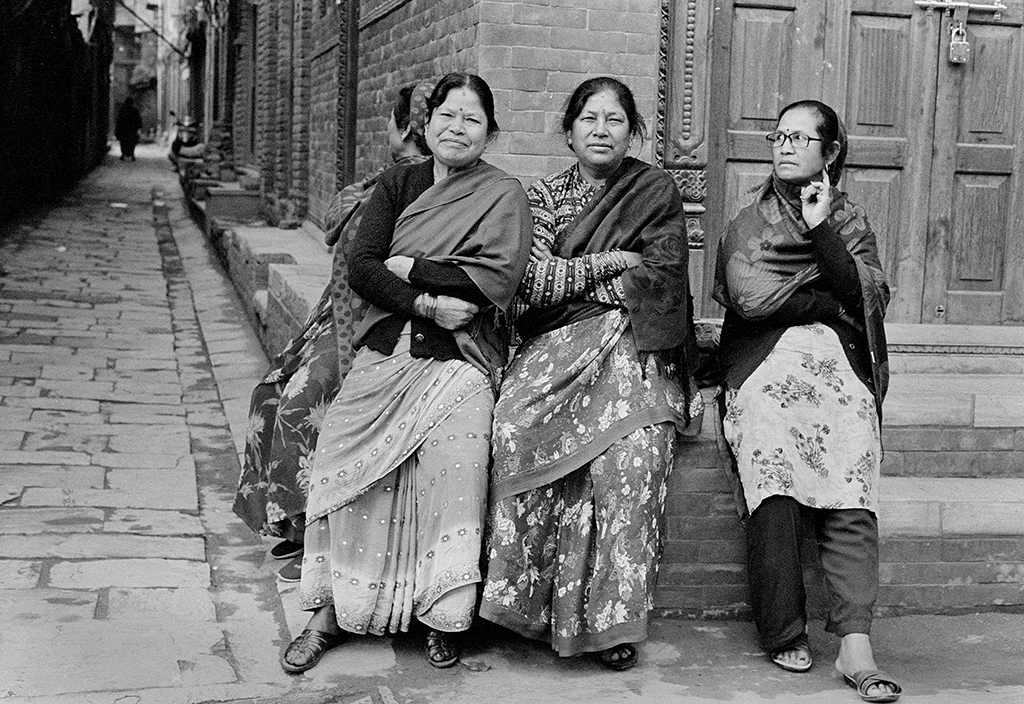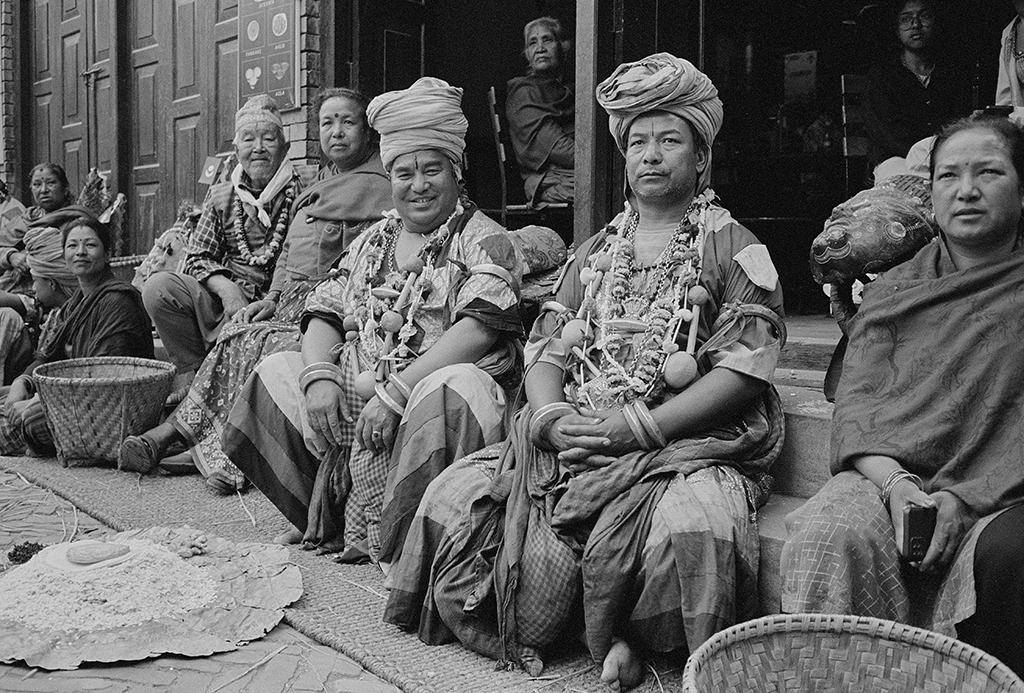This episode is about my return to Bhaktapur after a 3-year hiatus due to COVID-19. Still, those years kept me busy with my photography from Nepal: an exhibition in Tokyo entitled “Bhaktapur Is Calling” in 2022; a photography book “Nepal Is Calling” published in 2022; and preparation for a two-man exhibit “Bhaktapur Inside and Out” with the Nepali photographer Amit Banmala in 2023. Nepal and especially Bhaktapur was never far from my mind. Returning there after 3 years, I had some specific goals in mind, in addition to following my camera and Amit as my guide.

Women at the well. As I wrote previously, the public wells are a feature of the community. Each neighborhood has a community well where residents can draw water. The well is more than just a source of water. It also is a social meeting place for the women, who stay to chat with their neighbors before returning home.
Drawing water from the well for home use is a daily task, as the homes have no running water. The water in the small metal vessels is used for personal washing of the hands, feet and face. These wells have been in use for centuries.

An unsettling photograph. One of my themes is older people and this woman drew my attention as a subject. Many elements, especially the textures both in her shawl and the surroundings, foretold a moving portrait. Now I wonder. Her face telegraphs a disturbing message. Rather than the fine lines and wrinkles of old age, her face is like a mask. While I observed her for some time, she was unresponsive to the people around her, and they ignored her. Now I perceive the image differently – it is a strong but unnerving portrait.


Women at the window. A woman sitting at the second-floor window of her home in the late afternoon is a common sight in Bhaktapur, seemingly a counterpart to older women in Italy or in Italian neighborhoods in NYC. Characteristically, they appear to be passive, just watching or just listening, or maybe just sitting. This image mixes both of the themes, women at the well and women at the window, for this woman’s windows overlooked the square with its community well. Her home was in the old section of Bhaktapur, but the building was in remarkably good condition, both for the brick walls and the windows frames.
Women often congregate on the front steps of their homes. Each of these three women imparts a different impression, based on her body language and facial expression. They granted permission for the photograph, but now I wonder about the message from their gestures, their arms folded across themselves. I suspect this is just a common gesture, with no culture-specific meaning. The dynamic among the three women is the strength of the image, I think. Clearly the woman on the right had another opinion.

Consider two alternative interpretations of this image. As photorealism, the scene is part of a local custom, the open-air morning market. The vendors and customers alike are residents from the neighborhood. The vegetables set out on the sidewalk (are they garlic or some other vegetable?) are an advertisement about today’s goods.
As an art photograph, on the other hand, the interpretation is quite different. Whether these are garlics is immaterial. The similarity of the binding on each bunch and the repetition of the shapes are striking. As photorealism the wall would be simply the background, but as an art photograph the difference in texture between the wall and the vegetables is part of the dynamic.

Smoking in public has become taboo in many countries, but not so in Nepal. In the era before the anti-smoking movement, a photograph like this might have ben used to promote the supposed benefits of smoking. For me, though, the message is otherwise. Here is a man enjoying a quiet time sitting on a chair on the sidewalk. Minus the puff of smoke the message would be less clear.

Residents of Bhaktapur generally have been amenable to me and my camera. A simple hand gesture to the camera elicits permission from the subjects. The composition in this photograph has so many textures such as the man’s clothing and the background – but the most arresting feature is his face. A hint of a smile registers there but his eyes and his cheeks say it much more clearly. In one sense, this is just a man on a street but on a deeper level his inner character shines through. The image becomes a portrait rather than a picture. This is the spirit that draws me back to Bhaktapur.

Hindu culture. Hindu is the primary religion and culture in Nepal. I would readily admit that I know little about Hindu culture other than what I have observed. Hinduism, like Buddhism in other Asian countries, intrigues me though not enough to make a deeper study of it. I can observe but only as an outsider. He is the head monk of this temple. He will fulfill that role for one year and then another young boy will assume the role. Such a practice is rare in Bhaktapur and elsewhere in Nepal, as usually an elder monk assumes the role as head of the temple. The simplicity of the monk’s robes, his bare feet and shaved head make a sharp contract to the elaborate carvings that adorn the temple. The lad’s demeanor was quite solemn, which he projects in this image.

Another feature is Kumari, who is believed to be half human and half goddess. Nepali people revere Kumari highly and young married couples pray to her to grant them fertility. She will remain as Kumari until she reaches menarche, at which time a new Kumari, usually 2-3 years old, will assume the role. The expression on Kumari’s face in this photograph is difficult to put into words. Impassive is the term that comes to mind, or maybe ethereal would be more the mot juste in light of her status as a goddess on earth. Certainty her eyes seem to be fixed on something far in the distance.
Festivals. Bhaktapur, like other places in Nepal, hosts many festivals – lively colorful events that draw huge crowds of people. Dancers with brilliantly painted masks, tall headdresses, and long colorful robes often are among the main characters in a festival.


A family group during a festival called Indra Durga. One of the neighborhood elders, who is the head of the dancers troop, is flanked by his wife and his father on his right and by his younger brother on his left. The elaborate costumes of the men contrast sharply with the plain dress of the women. The camera angle unintentionally highlights the progression of generations.
In a lighter mood, this photograph captures a moment between one of the dancers at Indra Durga and a young girl. Any further description would only detract from the essence of the image. The composition is divided into three neat segments, with the man and girl forming the conventional triangle, but the subject is off-center making the image more dynamic. The plain surfaces of the background serve to emphasize the vivid texture of the two figures. In all, the photograph may be akin to Cartier-Bresson’s decisive moment.
Absent the context, this would be an unusual and curious image. The setting evokes a historic era and the men’s robes set them apart from the norm.


Allow me to end this episode with an image that is decidedly different from the others. Durbar Square is illuminated in the evening, though usually few people are there. This image shows one of the historic buildings lit up to emphasize its architecture. The camera angle takes the photograph out of the realm of photorealism and into the genre of art photography, or what I call “not-street-photography.” Bhaktapur abounds with subjects by night as well as by day, one of the features that draws me back.
This episode of The Monochrome Chronicles illustrates that, even after a 3-year hiatus, the old walled city of Bhaktapur draws me and my camera back. It expands the series from the previous episode (#13). A mix of portraiture, photorealism, and street photography creates this portrait of a community.